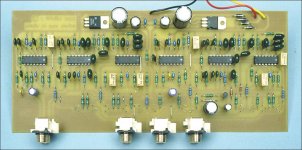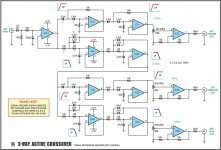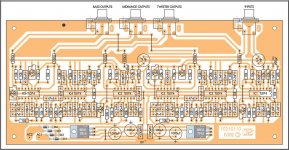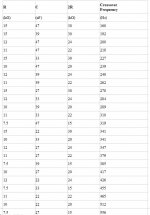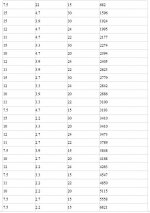I'm planning a pair of 3-ways in which there are going to be active crossovers and balanced line transmitters/receivers. I've been doing a lot of searching around and there's much disagreement on the best op-amps or how much they matter in certain applications so I wanted to check with people that my choices are at least not foolish:
# For the input stage of the x-overs (with around 6db of gain) and also for all the line drivers and receivers I was thinking of the LM4562NA. Its said to be fairly neutral and open which is probably good where there are potentially cumulative effects from a number in the chain. The OPA2134 was a close contender but actually seems more expensive these days, and I think its slight warmth would better suit my pre-amp.
# For the filter and output/buffer stages of the active crossovers, I was thinking of using the NE5532AP. I realise its not the most modern or highly specified these days, but it 'looks' acceptable for this role and is considerably cheaper. Its stable at unity-gain and is said to have decent driving capability. Being BJT, its not got an especially high input impedance (neither has the LM4562), but I'm thinking probably the right RC values could mitigate that.
I realise everyone will have their favourite, and it also depends on the forthcoming implementation. So rather than looking for agreement I'm mainly hoping people will flag up if they think these could actually be poor choices - e.g. would the old NE5532 let the side down, or could BJT impedances in the filter stage be more of an issue than I think.
Cheers
Kev
# For the input stage of the x-overs (with around 6db of gain) and also for all the line drivers and receivers I was thinking of the LM4562NA. Its said to be fairly neutral and open which is probably good where there are potentially cumulative effects from a number in the chain. The OPA2134 was a close contender but actually seems more expensive these days, and I think its slight warmth would better suit my pre-amp.
# For the filter and output/buffer stages of the active crossovers, I was thinking of using the NE5532AP. I realise its not the most modern or highly specified these days, but it 'looks' acceptable for this role and is considerably cheaper. Its stable at unity-gain and is said to have decent driving capability. Being BJT, its not got an especially high input impedance (neither has the LM4562), but I'm thinking probably the right RC values could mitigate that.
I realise everyone will have their favourite, and it also depends on the forthcoming implementation. So rather than looking for agreement I'm mainly hoping people will flag up if they think these could actually be poor choices - e.g. would the old NE5532 let the side down, or could BJT impedances in the filter stage be more of an issue than I think.
Cheers
Kev
Last edited:
Hi Kev,
One thing to remember is that all these stages are pretty much in series - like a chain, and we know about the chain being as strong as the weakest link.
Also for the filters, even if the i/o gain is 0dB, the internal voltages and current around the opamps of the filter (if it is one of the usual feedback filter types like Sallen & Key or State Variable) can be much higher than line level due to the effects of the reactive elements.
Seen from that perspective, it would probably be best to use the 'best' opamps for the filter stages.
If you want to use some NE5532's for economic reasons. use them for the i/o buffers and line driver/receiver and use the LM4562 or better for the filter stages.
Jan
One thing to remember is that all these stages are pretty much in series - like a chain, and we know about the chain being as strong as the weakest link.
Also for the filters, even if the i/o gain is 0dB, the internal voltages and current around the opamps of the filter (if it is one of the usual feedback filter types like Sallen & Key or State Variable) can be much higher than line level due to the effects of the reactive elements.
Seen from that perspective, it would probably be best to use the 'best' opamps for the filter stages.
If you want to use some NE5532's for economic reasons. use them for the i/o buffers and line driver/receiver and use the LM4562 or better for the filter stages.
Jan
Ah yes, thanks for that. I was so concerned about the chain being cumulative, I may have not thought enough about the weakest link.
My budget has suddenly become tight, but I've already spent so much on all this that I don't want to let it down at the last moment.
Cheers
Kev
My budget has suddenly become tight, but I've already spent so much on all this that I don't want to let it down at the last moment.
Cheers
Kev
Opamps do not have a "sound" per se. You have to understand which properties of the opamp are relevant in what kind of circuit and circuit topology. Study Samuel Groner's opamp measurements thoroughly.
You are essentially working between two limits: Noise on the bottom, and distortion and supply voltages on top. While your input and output levels hopefully are going to be reasonably well-defined, you have some liberty in levels in between. The ideal choice depends on the noise levels and driving abilities of the opamps in question. You neither want a hiss generator nor clipping to occur anywhere in the circuit in practice. Many classic audio parts are a fair bit more linear when operated in an inverting circuit due to the lack of common-mode and input impedance distortion, so the noise penalty (or higher driving requirements) of that one may well be worth it.
I'd suggest 5532s for the line drivers and receivers. Their common-mode weaknesses should not be overly relevant there, but their driving abilities are decent and their noise should be dominated by resistor noise easily. For the filter circuits themselves, best part choice would strongly depend on topology and impedances involved. A non-inverting topology in particular usually quite critical WRT input impedance and common-mode nonlinearity.
You are essentially working between two limits: Noise on the bottom, and distortion and supply voltages on top. While your input and output levels hopefully are going to be reasonably well-defined, you have some liberty in levels in between. The ideal choice depends on the noise levels and driving abilities of the opamps in question. You neither want a hiss generator nor clipping to occur anywhere in the circuit in practice. Many classic audio parts are a fair bit more linear when operated in an inverting circuit due to the lack of common-mode and input impedance distortion, so the noise penalty (or higher driving requirements) of that one may well be worth it.
I'd suggest 5532s for the line drivers and receivers. Their common-mode weaknesses should not be overly relevant there, but their driving abilities are decent and their noise should be dominated by resistor noise easily. For the filter circuits themselves, best part choice would strongly depend on topology and impedances involved. A non-inverting topology in particular usually quite critical WRT input impedance and common-mode nonlinearity.
Thank you for that, it is very helpful. There are clearly very basic/fundamental things I didn't understand about the selection criteria. <sigh>
It is a non-inverting topology I'll be using, although perhaps thats not terrible as I suspect noise may be more noticeable than (mild) non-linearity in my application. These stages are all after the volume control, so I will hear all hiss all the time, even (and in fact especially) when playing back at low volumes. The design I'll be using has an adjustable gain stage before the filters and then an attenuation stage at each output to balance the three driver's sensitivity, so 'hopefully' I'll be able to manage those to avoid clipping - through excessive gain followed by unnecessary attenuation.
Its beginning to seem like I may as well just keep things simple and go with the LM4562 throughout; most of the devices are in the filter stage so there wouldn't be much money to save by getting a few 5532s for the line tx/rx stages. Or possibly even the OPA2134; its slightly more costly, however the FET input may be better in the filter stages and I've seen a few posts suggesting it may be quite tolerant/flexible in real-world implementation, which given my lack of understanding could be helpful.
Thanks again,
Kev
It is a non-inverting topology I'll be using, although perhaps thats not terrible as I suspect noise may be more noticeable than (mild) non-linearity in my application. These stages are all after the volume control, so I will hear all hiss all the time, even (and in fact especially) when playing back at low volumes. The design I'll be using has an adjustable gain stage before the filters and then an attenuation stage at each output to balance the three driver's sensitivity, so 'hopefully' I'll be able to manage those to avoid clipping - through excessive gain followed by unnecessary attenuation.
Its beginning to seem like I may as well just keep things simple and go with the LM4562 throughout; most of the devices are in the filter stage so there wouldn't be much money to save by getting a few 5532s for the line tx/rx stages. Or possibly even the OPA2134; its slightly more costly, however the FET input may be better in the filter stages and I've seen a few posts suggesting it may be quite tolerant/flexible in real-world implementation, which given my lack of understanding could be helpful.
Thanks again,
Kev
is this from the xover o/p to the power amp? how long will these cables be?balanced line transmitters/receivers
hi,
sorry I should have said: the balanced lines will be between the pre-amp and the 3-way crossovers, so there will only be two (L&R) rather than six lines, but they will be full-range. I'm going to have the crossovers and power amps very close together, probably in the same box in fact, so I hadn't intended to use balanced interconnects between them.
I mentioned the full-range thing because I see some people have suggested one can use less well specified components for the mid and especially bass channels in/after the active crossover. I can understand that, though personally I'd not be able to bring myself to economise on the mid range either, so the savings would just be on the bass (and any extra/provisional sub-woofer filters I decide to build in).
The LM4562 or the OPA2134 aren't hugely expensive in themselves (I just need rather a lot of them), so savings in the odd place or two wouldn't gain all that much. It'd be much more important if I were going for 'really' premium jobs, but currently I'm not planning to go beyond the OPA2134 even in my pre-amp.
I think I'll just get LM4562s or OPA2134s throughout and have done with it, I may be changing my mind and be leaning towards the OPA2134 now, but from what I can gather they're both more or less in the same league so probably it wouldn't matter hugely. Perhaps the choice between them is more a question of whether I want BTJ or FET
Cheers
Kev
sorry I should have said: the balanced lines will be between the pre-amp and the 3-way crossovers, so there will only be two (L&R) rather than six lines, but they will be full-range. I'm going to have the crossovers and power amps very close together, probably in the same box in fact, so I hadn't intended to use balanced interconnects between them.
I mentioned the full-range thing because I see some people have suggested one can use less well specified components for the mid and especially bass channels in/after the active crossover. I can understand that, though personally I'd not be able to bring myself to economise on the mid range either, so the savings would just be on the bass (and any extra/provisional sub-woofer filters I decide to build in).
The LM4562 or the OPA2134 aren't hugely expensive in themselves (I just need rather a lot of them), so savings in the odd place or two wouldn't gain all that much. It'd be much more important if I were going for 'really' premium jobs, but currently I'm not planning to go beyond the OPA2134 even in my pre-amp.
I think I'll just get LM4562s or OPA2134s throughout and have done with it, I may be changing my mind and be leaning towards the OPA2134 now, but from what I can gather they're both more or less in the same league so probably it wouldn't matter hugely. Perhaps the choice between them is more a question of whether I want BTJ or FET
Cheers
Kev
A resurrection of the thread; theres been a delay in proceedings but I'm hoping to start the project again now. I previously bought a pair of ESP Project 125 boards, which are light-years ahead of what I could have managed on strip-board. Functionally, they each comprise a balanced line receiver, gain/volume stage, linkwitz-riley crossover stages (which I'm going to employ for high, mid and bass crossovers plus a rumble/bass-excursion-protection filter), and an output stage.
After a bit more research I was going to get all LM4562 (LME49720) op amps, partly for economy of volume-purchase. But then discovered I've already got several OPA2134's. If I'm interpreting things correctly, Doug Self seems to feel the OPA2134's are decent but somewhat beaten by the LM4562's at higher frequencies, and in particular with output loading.
So I'm now thinking to use the existing OPA2134's for the mid-range and bass active crossover filters, perhaps erring towards higher value resistors in their R/C companion components as (if I understand correctly) the fet inputs are better with voltage noise than current noise. I still need more op-amps than I have though, so I could get LM4562's for the tweeter crossover, plus the balanced line receiver, gain stage and output stages. Then Ne5532's for the rumble filter.
I'm not able to afford anything exotic in the numbers required for this project. So, whilst I appreciate there are many many alternatives, do these choices seem reasonable?
Thanks
kev
After a bit more research I was going to get all LM4562 (LME49720) op amps, partly for economy of volume-purchase. But then discovered I've already got several OPA2134's. If I'm interpreting things correctly, Doug Self seems to feel the OPA2134's are decent but somewhat beaten by the LM4562's at higher frequencies, and in particular with output loading.
So I'm now thinking to use the existing OPA2134's for the mid-range and bass active crossover filters, perhaps erring towards higher value resistors in their R/C companion components as (if I understand correctly) the fet inputs are better with voltage noise than current noise. I still need more op-amps than I have though, so I could get LM4562's for the tweeter crossover, plus the balanced line receiver, gain stage and output stages. Then Ne5532's for the rumble filter.
I'm not able to afford anything exotic in the numbers required for this project. So, whilst I appreciate there are many many alternatives, do these choices seem reasonable?
Thanks
kev
My own experience is that TL084s work fine for active crossovers provided the impedances are kept high enough so that their output stages get nowhere near leaving the classA portion of their load line. Since they're so cheap, and given the high resistor values the caps are also small and very cheap (NP0) I run them fully balanced.
Using bipolar input opamps necessitates lower impedances (due to their input noise current) and hence biassing the output stages into classA with an additional CCS might be worthwhile subjectively.
Using bipolar input opamps necessitates lower impedances (due to their input noise current) and hence biassing the output stages into classA with an additional CCS might be worthwhile subjectively.
I'm planning a pair of 3-ways in which there are going to be active crossovers and balanced line transmitters/receivers. I've been doing a lot of searching around and there's much disagreement on the best op-amps or how much they matter in certain applications so I wanted to check with people that my choices are at least not foolish:
# For the input stage of the x-overs (with around 6db of gain) and also for all the line drivers and receivers I was thinking of the LM4562NA. Its said to be fairly neutral and open which is probably good where there are potentially cumulative effects from a number in the chain. The OPA2134 was a close contender but actually seems more expensive these days, and I think its slight warmth would better suit my pre-amp.
# For the filter and output/buffer stages of the active crossovers, I was thinking of using the NE5532AP. I realise its not the most modern or highly specified these days, but it 'looks' acceptable for this role and is considerably cheaper. Its stable at unity-gain and is said to have decent driving capability. Being BJT, its not got an especially high input impedance (neither has the LM4562), but I'm thinking probably the right RC values could mitigate that.
I realise everyone will have their favourite, and it also depends on the forthcoming implementation. So rather than looking for agreement I'm mainly hoping people will flag up if they think these could actually be poor choices - e.g. would the old NE5532 let the side down, or could BJT impedances in the filter stage be more of an issue than I think.
Cheers
Kev
This was a nice one I used, subbed the TLO74's for LME4970's. Buffers each end.
Active 3-Way Crossover For Loudspeaker Systems - January 2003 - Silicon Chip Online
Cheers George
Attachments
Apologies to Doug Self, it was actually Samuel Groner's test results I was using for the above info. Though IIRC Doug didn't seem to rate the OPA2134's over the LM4562 either.A resurrection of the thread; theres been a delay in proceedings but I'm hoping to start the project again now. I previously bought a pair of ESP Project 125 boards, which are light-years ahead of what I could have managed on strip-board. Functionally, they each comprise a balanced line receiver, gain/volume stage, linkwitz-riley crossover stages (which I'm going to employ for high, mid and bass crossovers plus a rumble/bass-excursion-protection filter), and an output stage.
After a bit more research I was going to get all LM4562 (LME49720) op amps, partly for economy of volume-purchase. But then discovered I've already got several OPA2134's. If I'm interpreting things correctly, Doug Self seems to feel the OPA2134's are decent but somewhat beaten by the LM4562's at higher frequencies, and in particular with output loading.
So I'm now thinking to use the existing OPA2134's for the mid-range and bass active crossover filters, perhaps erring towards higher value resistors in their R/C companion components as (if I understand correctly) the fet inputs are better with voltage noise than current noise. I still need more op-amps than I have though, so I could get LM4562's for the tweeter crossover, plus the balanced line receiver, gain stage and output stages. Then Ne5532's for the rumble filter.
I'm not able to afford anything exotic in the numbers required for this project. So, whilst I appreciate there are many many alternatives, do these choices seem reasonable?
Thanks
kev
Thanks abraxalito, I must say I'm surprised at that - given how they measure I'd have expected (within the fet input types) the OPA2134's to be noticeably better then the TL082's, particularly WRT noise and distortion. Perhaps the real-world requirements for the filter op-amps are more modest than I'd believed, then.
Thanks also George. I'm not sure how the 4970's you used relate to my choices, but at least one reference I found suggests its similar to the LM4562 I'm considering so thats potentially helpful too.
Thanks
Kev
This was a nice one I used, subbed the TLO74's for LME4970's.
I concur with that substitution, using 10k resistors throughout won't allow TL074s to shine. Scale 10ks up to 220k (and of course the 2n2 caps down to 100pF) though and it'll probably sound more transparent than all but the best amps.
Buffers each end.
Yep definitely don't use a TL07x to drive an interconnect.
@Kev - initially I was just as surprised that TL084s could do the job. I used to build passive (line level) XOs but no need now with such good results from such humble opamps. Quite probably the measurements will show up distortion as the input capacitance of JFET opamps is non-linear and hence gives rise to increasing distortion with higher passive component impedances. However subjectively I notice no issues with distortion when going to higher working impedance, only the substantial dynamics improvement from reducing the PSU noise.
Last edited:
Thats really helpful, thanks to both of you. I've calculated some C & R values but they seemed pretty arbitrary as of course these can be scaled either way, so its good to get an idea of what sensible values are.
For once, this could end up being substantially cheaper than I'd feared.
EDIT: I can't find George's LME4970, but if its the LME497xx family which includes LME49710 and LME49720, then the latter is said by some to be the same as the LM4562 I was proposing (just renamed to bring it into their LME range). If so thats good stuff!
Thanks again
Kev
For once, this could end up being substantially cheaper than I'd feared.
EDIT: I can't find George's LME4970, but if its the LME497xx family which includes LME49710 and LME49720, then the latter is said by some to be the same as the LM4562 I was proposing (just renamed to bring it into their LME range). If so thats good stuff!
Thanks again
Kev
Last edited:
Great, thanks George, that has helped me identify it now. I'd need the twin version of your LME49740, which (not unreasonably) is apparently called LME49720. A bit more poking about on the forum suggests that this is the LM4562 simply renumbered to give it a presence in the newer LME designations. (FWIW the LME49860 is said to be the same chip again, but selected as the cream of the crop for slightly higher voltage suitability).
The naming conventions may be a bit complicated, but in its various guises the chip itself gets good test results for its mid-range price, so continues to look like a good choice for me. Although I'm still then forced to decide how best to divvy out the roles across these and my existing OPA2134s.
Thanks again,
kev
The naming conventions may be a bit complicated, but in its various guises the chip itself gets good test results for its mid-range price, so continues to look like a good choice for me. Although I'm still then forced to decide how best to divvy out the roles across these and my existing OPA2134s.
Thanks again,
kev
- Status
- This old topic is closed. If you want to reopen this topic, contact a moderator using the "Report Post" button.
- Home
- Source & Line
- Analog Line Level
- Op amps for active Xover and line drivers
